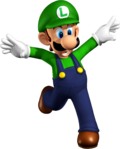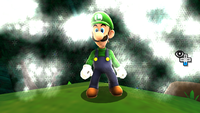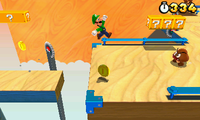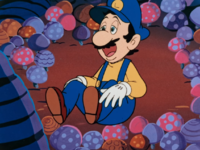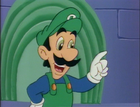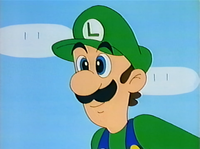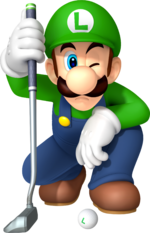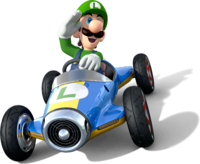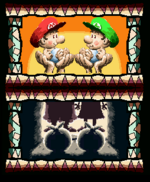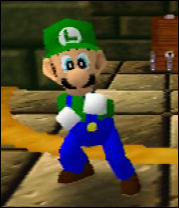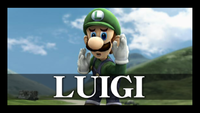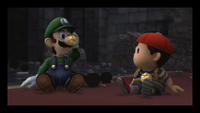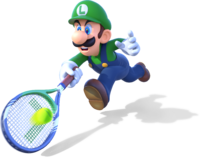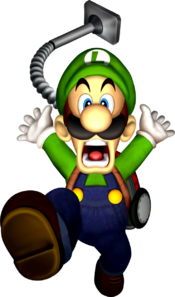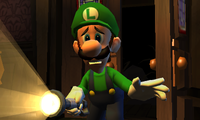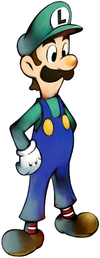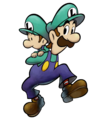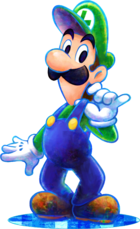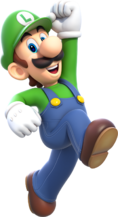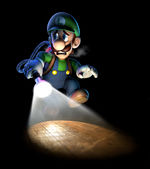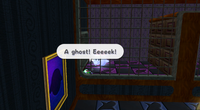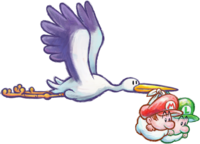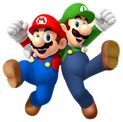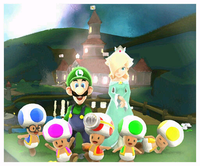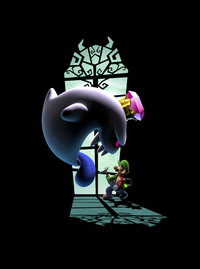Luigi: Difference between revisions
mNo edit summary |
Mikeruler17 (talk | contribs) |
||
| Line 113: | Line 113: | ||
====''Super Mario Maker''==== | ====''Super Mario Maker''==== | ||
Luigi appears as an unlockable [[Mystery Mushroom]] [[Costume Mario|costume]] in ''Super Mario Maker''. The costume can be unlocked either at random upon completion of the 100-Mario Challenge, or by scanning a compatible Luigi [[amiibo]]. The costume replaces some of the usual ''Super Mario Bros.'' sounds with sounds from ''Luigi's Mansion''.He also appears on the Splash Screen of the | Luigi appears as an unlockable [[Mystery Mushroom]] [[Costume Mario|costume]] in ''Super Mario Maker''. The costume can be unlocked either at random upon completion of the 100-Mario Challenge, or by scanning a compatible Luigi [[amiibo]]. The costume replaces some of the usual ''Super Mario Bros.'' sounds with sounds from ''Luigi's Mansion''. He also appears on the Splash Screen of the game on Sundays. | ||
===''Wrecking Crew''=== | ===''Wrecking Crew''=== | ||
Revision as of 20:07, July 23, 2016
It has been requested that this article be rewritten. Reason: it has inconsistent tenses, image clutter, and bad writing that violates policy, and it requires an expansion (tagged on 15:51, 20 October 2015 (EDT))
- “Eek! No one told me there would be gh-gh-ghosts here! I wish I'd brought my Poltergust 3000 with me.”
- —Luigi, Fortune Street
Luigi (Japanese: ルイージ, Ruīji) is Mario's younger, taller, thinner twin brother. He is a major protagonist of the Mario series. Luigi has helped and fought alongside his brother on many occasions. Throughout his life, he has lived in Mario's shadow, developing both cowardly and heroic tendencies. Mario Bros. marks his first appearance in the Mario series and his debut in general. Originally a palette swap of Mario, Luigi was created to facilitate a second player option. Since the two-player mode was dropped from most main Super Mario games beginning with Super Mario Land, Luigi has gained his own identity and personality. This is especially noticeable in installments for the Luigi's Mansion series of games, as well as the Mario & Luigi series.
Creation and development
Luigi was created when Shigeru Miyamoto set out to create Mario Bros.[1] after being told that Mario resembled a plumber, a notion he wanted to officially establish.[2] After observing the two-player competitive and cooperative gameplay of the arcade game Joust, Miyamoto wished to incorporate a similar style of gameplay into his own game.[2][3] Miyamoto's answer to Joust's stork-riding player 2 was Luigi, a younger twin brother to Mario, with whom he could compete or cooperate. While Mario's name was based on Mario Segale, Luigi's name is said to have been based on a popular pizzeria near Nintendo of America's headquarters, named Mario & Luigi's[4]; coincidentally, his name was also noted to be similar to the Japanese word 「類似」 (ruiji), meaning "similar"[5], which was one of the reasons why Luigi was a simple palette swap of Mario in the older games. With the 2-player mode in mind, Nintendo and publishing companies such as Atari gave Luigi immediate publicity, making him the star and center of attention in many advertisements for the game.[6][7]
Since his debut in 1983, Luigi has been constantly developing. Gameplay differences between him and Mario were first seen in Super Mario Bros.: The Lost Levels, which have been carried over into future games and have become standard for the character. After spending years as a palette swap of his brother, Luigi has consistently been given his own graphics since Super Mario Kart in 1992 to match his official appearance as Mario's taller, younger brother; the American Super Mario Bros. 2, however, is an exception to this. As aforementioned, Luigi was later given more of a personality; it was as early as the DiC cartoons that Luigi was shown to be the more cautious of the two brothers, though it was not until Luigi's Mansion that this was truly established.
In 2013, Luigi was the focus of the Year of Luigi, where in Nintendo released a number of themed games and merchandise and held events to honor the thirtieth anniversary of Luigi's first appearance in Mario Bros.
History
Mario Bros.
Luigi's first playable appearance is in Mario Bros., where he is simply a palette swap of Mario with the same controls and abilities. There are no other differences in physical appearance. In the game, Luigi and Mario are portrayed as plumbers, who are trying to rid the sewers where they are working from Shellcreepers, Slipices, and many other monstrous creatures.
Luigi was played by an unknown actor in a live-action commercial for the Atari 2600 version of Mario Bros.. The commercial portrays Luigi as a coward. It is unknown if this might have inspired Luigi's current personality or not.
Super Mario series
Super Mario Bros.
Luigi appears in Super Mario Bros., where he has the same jumping powers, same traction, and the same running speed as Mario. He is only playable in 2-player mode.
Super Mario Bros.: The Lost Levels
Luigi appears in the Japan-only sequel of Super Mario Bros., Super Mario Bros.: The Lost Levels. For the first time, Luigi could now jump higher and further than Mario, but he has less traction. He was no longer the second player, but a different playable character.
Super Mario Bros. 2
Luigi is one of four playable characters in Super Mario Bros. 2, where, like the Japanese version, he could jump higher than anyone else. He is the second weakest in the group. This is the first game where Luigi isn't a recolor of Mario's sprite.
Super Mario Bros. 3
In Super Mario Bros. 3, Luigi is the same as he was in Super Mario Bros., only this time he can use more items, and carry things. Again, he is only in 2-player mode.
Super Mario World
Luigi appears in Super Mario World with the same abilities as in past games, this time he can Spin Jump. In the GBA port, Luigi had different abilities to set him apart from Mario, such as his scuttle jump, and his Yoshi being able to spit out enemies. Luigi has different appearances in all three versions, as shown in the picture.
Super Mario 64 DS
While Luigi does not appear in the final version of Super Mario 64, he does appear in its remake Super Mario 64 DS. Luigi, along with Mario and Wario, enter Princess Peach's Castle after she invites them. Bowser and his Koopa Troop then took over the castle and captured each of the plumbers. Luigi was locked behind a door, and the key to the door was guarded by King Boo. Eventually, Yoshi, who was sleeping on the castle roof and was not captured by Bowser's troop, manages to rescue Mario, who in turn manages to find King Boo's hideout and defeats him in battle, allowing him to get the key needed to free Luigi. While Luigi himself is needed to get certain stars, several Luigi Caps can be found on every course after he's been rescued. The Luigi caps allow the wearer to mimic Luigi's appearance, attributes and abilities perfectly, save for his voice. Luigi is also the only character who could save Wario from Chief Chilly's grasp, as he was needed to walk through a mirror using his invisibility flower to get to Wario's painting.

Although Luigi runs a bit slower than his brother Mario, the instruction booklet for Super Mario 64 DS says that he has the greatest agility (though he does swim faster than the other characters). Luigi is also the best jumper, tied with Yoshi, but is the second weakest character, meaning he takes longer to pick up enemies and walks slower while carrying them. If Luigi performs a backward somersault, he does a Spin Jump, similarly to what happens when any of the characters jumps on a Fly Guy. Luigi can also Scuttle for a short period of time (a reference to the trait applied to him in the Super Mario Advance remakes of SNES games), and he can also run on water for a few seconds because of his lighter body. Luigi's ability from a Power Flower is to become invisible, similar to the invisible power Mario gets in the original game when wearing the Vanish Cap. This ability allows him to evade enemies and run through certain interfaces.
All of Luigi's minigames from the Rec Room, some also reused in New Super Mario Bros.'s minigame mode, revolve around gambling games. Luigi acts as the dealer in all of the card games, and he does not wear his usual attire, instead wearing a white shirt with a black vest and a green bow tie.
New Super Mario Bros.
In New Super Mario Bros., Princess Peach was kidnapped and had to be saved by Mario and Luigi. This time, she is kidnapped by Bowser Jr., Bowser's son. The Mario Bros. set out on their adventure to save the princess. Mario and Luigi travel to the many areas of the Mushroom Kingdom, fighting the many enemies that Bowser and Bowser Jr. put in their way. At the castle in World 8, Mario and Luigi ended up fighting Dry Bowser (an undead version of Bowser). After being tricked into believing that they had finally defeated Bowser, Bowser Jr. steals Peach and the Mario Bros. follow him to Bowser's Castle where they finally confront a now-revived, bigger Bowser and Bowser Jr.. Again, the Mario Bros. defeat Bowser and his son and rescue Peach once again. After the credits roll, the secret code to play as Luigi is revealed as ![]() +
+![]() +
+![]() , though, the player can choose Luigi even before the player finishes the game as his brother. Luigi will say his name to indicate that the code worked correctly. His role is the same as Mario's. Luigi also appeares in this game's multiplayer mode "Mario vs. Luigi" where he battles Mario for Big Stars. Luigi also appears in some of the minigames, Whack-a-Monty, and the card games, some of which return from Super Mario 64 DS.
, though, the player can choose Luigi even before the player finishes the game as his brother. Luigi will say his name to indicate that the code worked correctly. His role is the same as Mario's. Luigi also appeares in this game's multiplayer mode "Mario vs. Luigi" where he battles Mario for Big Stars. Luigi also appears in some of the minigames, Whack-a-Monty, and the card games, some of which return from Super Mario 64 DS.
Super Mario Galaxy
Luigi appears in Super Mario Galaxy. When Bowser abducts Peach's Castle, Luigi and the Toad Brigade are apparently inside. However, they all escape and get lost in space. Luigi is imprisoned in the Ghostly Galaxy. Mario must come and rescue him, after which he will help Mario in three different galaxies, by collecting stars (although he gets lost every time and must be rescued). After collecting three stars, Luigi leaves the rest up to Mario.
After the player collects all 120 Power Stars and defeats Bowser again, the player has to play as Luigi in order to collect the next 120 Power Stars. There are several differences when playing as Luigi: he can run faster, but takes more time to build up speed; it is harder for him to stop running; he can jump higher and further; and the air meter depletes faster while spinning underwater. Additionally, Cosmic Luigi is faster and more intelligent than Cosmic Mario while racing.
While Luigi is being used, the stars that has required Mario to meet Luigi still feature a non-playable Luigi, bringing up the issue of two Luigis in the game. The playable Luigi is shorter and has a different head shape than the NPC Luigi, likely adjusted to fit Mario's build. When the playable Luigi first saves the non-playable one from the Ghostly Galaxy, Luigi dismisses his rescuer merely as someone in the universe who happens to look like him. When Luigi rescues himself afterwards, the lost Luigi refers to him as "me" (for example, "I knew I could rely on... me!"). Rosalina dismisses the two as twins. When the Mailtoad has mail, the letter will say it is for Mario, and the Mailtoad feels bad for Luigi. The NPC Luigi calls Mario "bro" in his letters. Also, some letters may contain 20 1-Up Mushrooms, instead of 5.
New Super Mario Bros. Wii
Luigi appears in New Super Mario Bros. Wii. The game begins at Peach's Castle, where the princess's birthday is being celebrated. A large cake suddenly arrives, which is revealed to be a trap; Bowser Jr. and the Koopalings burst out, then kidnap Peach. Mario, Luigi, Blue Toad, and Yellow Toad, all attendees of the party, venture through the Mushroom Kingdom to rescue her, this time not only with his brother, but with the two Toad companions. Later in the story, after Bowser is defeated, he opens the door for Mario and Peach in his hot-air balloon but they take off and leave Luigi behind. Blue and Yellow Toad take him in theirs instead. Also, when a player hits the Super Guide Block, Luigi will guide the player through the level the player is stuck on. He can also be played in co-op mode.
Super Mario Galaxy 2
- “Hey, Bro! I'm all over the place these days, exploring the universe!”
- —Luigi, Super Mario Galaxy 2
Luigi appears in Super Mario Galaxy 2 where he often teams up with Mario and Yoshi to save the universe from being ruled by Bowser, and to retrieve the Power Stars.
As a playable character, he is controlled the same way as in Super Mario Galaxy and is still unlockable. Luigi can be found at the beginning of some levels. When Mario walks over and talks to Luigi, he will ask Mario if he can get the Power Star instead. In this game, like in Super Mario Galaxy, he is faster and can jump higher than Mario but is harder to stop. Also, completing levels with Luigi will unlock staff ghosts for as many missions as the player is able to complete as Luigi. If the player uses the Co-Star Luma to spin in front of Luigi when he appears in a galaxy, he releases several Star Bits.
Once the player completes Bowser's Galaxy Generator, they can alternate between using Mario or Luigi, via the Starship Mario; the Mailtoad will have mail from Luigi, telling the player that Mario can now switch with Luigi.
This game differs from the first game in that Mario can switch to and from Luigi while under the same game file, as opposed to leaving the game file and switching from Mario to Luigi or vice versa via a button on the game file selection screen.
Super Mario 3D Land
Luigi appears as a playable character in Super Mario 3D Land, where he plays like he did in Super Mario Bros. The Lost Levels and the Super Mario Galaxy games, having a better jump in exchange for worse traction. Mario can unlock Luigi in the first castle in Special World 1. He is held prisoner by Dry Bowser and can be unlocked by defeating him. He cannot use the Invincibility Leaf or the P-Wing unless the player skips a level as Mario in the Normal Worlds by using a Warp Zone.
Tanooki Luigi appears differently from Tanooki Mario; while the latter appears like a tanuki, the former actually appears like a kitsune (a Japanese Fox) rather than a tanuki like in Super Mario Bros. 3, being given honey colored fur and a fox-like tail and ears. Most foreign languages also call this form of Luigi "Kitsune Luigi."
New Super Mario Bros. 2
Luigi reappears in New Super Mario Bros. 2 as the second player in the Co-Op Mode. His Raccoon form is similar to his Tanooki form in Super Mario 3D Land, looking more like a kitsune or a fox rather than a raccoon, and in order to differentiate from Gold Mario, his Gold Flower form is metallic silver instead. After beating Bowser in World 6, Luigi is unlocked as a playable character in the single player story mode. To play as Luigi, the player must hold +
when starting the game. He is not playable in the Coin Rush mode. When the player as Luigi finishes World 6-Bowser's Castle, the credits will not roll as he is not available in the main storyline yet.
New Super Mario Bros. U
Luigi reappears in the game New Super Mario Bros. U along with Mario, Toads and Miis. He is a playable character only in multiplayer mode. The game starts off with them enjoying some cake with Princess Peach, but their dessert is soon interrupted by Bowser and the Koopalings' airships which invade the castle and throw the Mario Bros. and the Toads to the far off Acorn Plains. The bros and the Toads then begin their journey back to Peach's castle to save her and stop Bowser.
New Super Luigi U
To celebrate 2013 as the Year of Luigi, Luigi reappears as the main playable character in New Super Luigi U, with Mario making no appearance in the expansion pack. In this game, Luigi is given his unique play style again; he jumps higher and farther than Mario, but has worse traction, as in other titles such as Super Mario Bros.: The Lost Levels.
Super Mario 3D World
Luigi returns in Super Mario 3D World. Like with past 3D Mario titles, he retains his trademark abilities, being able to jump higher than the other playable characters, but stopping more slowly when moving on the ground.
Luigi is also featured as the playable character in the game's "Luigi Bros." minigame, a game identical to Mario Bros. but featuring Luigi as the main playable character.
Super Mario Maker
Luigi appears as an unlockable Mystery Mushroom costume in Super Mario Maker. The costume can be unlocked either at random upon completion of the 100-Mario Challenge, or by scanning a compatible Luigi amiibo. The costume replaces some of the usual Super Mario Bros. sounds with sounds from Luigi's Mansion. He also appears on the Splash Screen of the game on Sundays.
Wrecking Crew
Luigi was once again the second player in Wrecking Crew. Luigi's sprite was still a palette swap of Mario's, but this time Luigi was dressed in red and had purple eyes and hair with a purple hammer. In this game, Mario and Luigi worked on a demolition site. The goal was to break down every stone wall on each stage. Defeating enemies in this game was not easy, as Mario and Luigi's regular hammer dealt them no damage. However, it could make Foreman Spike fall down if one of the Mario Bros. could hit him with it. If an enemy wanders underneath a drum, Mario or Luigi could trap them by causing the drum to fall.
Super Mario Bros.: Peach-hime Kyushutsu Dai Sakusen!
The first animated Luigi appeared in the anime movie Super Mario Bros.: Peach-hime Kyushutsu Dai Sakusen! ("Super Mario Bros.: The Great Mission to Rescue Princess Peach!"), where he was voiced by Yuu Mizushima. For some reason, he was mis-colored in the movie as wearing a blue cap and overalls and a yellow shirt (and a red shirt in the promotional artwork for the anime), although it may be worth noting that, at the time of Peach-hime Kyushutsu Dai Sakusen!'s creation, Luigi had not yet been given a consistent palette and his current color scheme had not been introduced in-game. The anime also marked the first time Luigi was ever given a personality; Peach-hime Kyushutsu Dai Sakusen! depicted Luigi as very greedy, typically thinking only of profits and characterized by his pick-axe and shovel, both of which he used to mine for Coins. (As a matter of fact, Luigi often left adventuring with Mario and Kibidango to search for Coins, though he usually ended up helping them progress in various ways through his miserly efforts.) Luigi in the anime was also noticeably more serious and less dreamy than Mario, and he seemed to lack his brother's almost otherworldly connection to Princess Peach.
Amada Anime Series: Super Mario Bros.
Luigi also appeared in another anime, the Amada Anime Series: Super Mario Bros., which depicted as wearing his traditional blue overalls and green shirt. Luigi only appears in the last story of the Super Mario anime series film, Shirayuki-hime (Snow White) appearing just in time to save Mario and Princess Peach from King Koopa, who was portrayed as the stories' wicked queen.
DIC cartoons
Luigi appeared in all ninety-one episodes of the three cartoon series produced by DIC Entertainment, though Mario only appeared in ninety episodes. In these cartoons, he was given green eyes instead of the usual blue that he has in the games. Luigi is the only character to appear in every episode of the DIC Mario cartoons.
The Super Mario Bros. Super Show!
In the television series The Super Mario Bros. Super Show!, Luigi, portrayed by Danny Wells, is seen living in Brooklyn together with Mario in the live-action segments. Like his brother, Luigi works as a plumber, running Mario Brothers Plumbing together with him. The episode Plummers Academy shows that he graduated from the Brooklyn Plumbers Academy together with Mario. The live-action segments show the two as having gained a reputation for their plumbing skills, even being awarded the title Plumbers of the Year in the segment of the same name. In the cartoon segments of the show, Luigi regularly joins his brother in various adventures in the Mushroom Kingdom. The Super Mario Bros. Super Show! is the origin of Luigi's cautious, easily-frightened personality which Nintendo later brought into the games as well, including Luigi's Mansion.
The Adventures of Super Mario Bros. 3
Luigi is played by Tony Rosato in the two cartoon follow-ups to the Super Show: The Adventures of Super Mario Bros. 3 and Super Mario World. The former is almost exactly like the Super Show, except the Koopa Kids join their father in making trouble for Luigi and the others.
In the episode The Beauty of Kootie, Casanova Koopa is what Luigi turned into to trick Kootie Pie into letting Toad, Toadstool, and the King of Desert Land free. Kootie tricked Mario by having her brother Cheatsy change her into a human so she could flirt with him and distract him in order to carry out their plan. After the trick was revealed and the Mario brothers got away, Mario used a swiped magic wand to transform Luigi into Kootie's "dream reptile" as a distraction. The trick worked for awhile, but after Casanova Koopa tricked Kootie Pie into releasing the prisoners and Kootie started kissing him, she accidentally activated her wand. Subsequently, Luigi was reverted into his true state, which made Kootie Pie scream and chase him with Cheatsy behind her.
Super Mario World
The Super Mario World television series shifts the setting from the Mushroom Kingdom to Dinosaur World, but once again, is relatively the same as the earlier cartoons, with Mario, Luigi, Princess Toadstool stopping the evil plots of King Koopa and his Koopa Kids. However, the heroes are now aided by the dinosaur Yoshi (replacing Toad), who was actually discovered by Luigi, who found a Yoshi Egg after falling down a waterfall. When he hatched, Yoshi affectionately called Luigi Mama Luigi.
Super Mario World: Mario to Yoshi no Bōken Land
Luigi is a main character in the interactive OVA Super Mario World: Mario to Yoshi no Bōken Land. He is part of a group trying to rescue Princess Peach from King Koopa. His appearance is notable for being one of the earliest examples of his cowardly personality, depicting him and Yoshi initially being too scared to enter a Ghost House. He also gets easily angered when Mario triggers an explosion when Luigi is in blasting range, and everyone laughs at him, causing him to adandon the mission. However, he eventually overcomes this through his love for his brother and Princess Peach, and comes to the rescue when Mario is having trouble fighting King Koopa.
Mario Golf series
Luigi has appeared in every game of the Mario Golf series. His first appearance was in NES Open Tournament Golf. In the game, Luigi's caddy was Princess Daisy.
Luigi reappeared in Mario Golf. A default character in the Game Boy Color version, he was one of the first characters that could be unlocked in the Nintendo 64 version by beating him on the "Get Character Mode". He had a unique course (in the sense that it was the only course in the game set up like a mini-golf course) named Luigi's Garden. He had a drive of 220 yards and his shot was "Fade".
He made his fourth appearance in Mario Golf: Toadstool Tour as a default character. In the game opening, he and Mario were admiring a trophy when Princess Peach and Princess Daisy called to them saying that it was time to tee off. Luigi, along with his brother and the two princesses, were shown making perfect tees, making Wario and Waluigi envious. After a series of mess ups, Wario and Waluigi accidentally hit Bowser in the eye with a result of giving Bowser a black-eye with their golf ball. Enraged, Bowser started chasing them in his Koopa Clown Car, throwing Bob-ombs at them. He eventually trapped them, threatening to drop a bomb right on them. Mario, who had Luigi, Daisy, and Peach right behind him, hit the golf ball, making it knock the bomb out of Bowser's hand, ultimately resulting in an explosion claiming Wario, Waluigi, and Bowser as its victims. Luigi, along with the other three who were with him, stood there shocked, not knowing what caused the explosion. In this game he has a fade with low trajectory and can hit 207 yards, 240 when starred.
Although Luigi is not a default character in Mario Golf: Advance Tour, he is unlockable by linking the Game Boy Advance and the Nintendo GameCube.
Luigi is a default playable character in Mario Golf: World Tour. Yet again, he has a low shot with a fade. His Star character is unlocked by completing a match challenge on Cheep Cheep Lagoon.
Club Nintendo
Luigi also made several appearances in the Club Nintendo comic series, usually as a companion of his brother Mario. In the story "Super Mario: Im Rausch der Geschwindigkeit", however, Luigi worked as a policeman and actually imposed a fine on Mario when the latter was violating the speed limit of Brooklyn while riding Yoshi. Luigi also insisted on being called "Officer Luigi."
Super Mario Adventures
The Super Mario Adventures comic serial's depiction of Luigi, oddly, features him in an opposite portrayal to his personality in the games and cartoons. In the first installment, Luigi wants to eat his lunch first and whines about his hunger as Mario continues with their plumbing job. Later, Luigi is actually willing to go into a Ghost House that Bowser has set as a trap for them, despite Mario's warnings, and then ends up going in when Bowser lets loose the scent of a giant hunk of aged provolone cheese. It is also worth noting is that Luigi disguises himself as Princess Peach to infiltrate the Koopalings' hideout at one point, a strategy he would later use in Mario & Luigi: Superstar Saga.
Mario Kart series
Luigi has appeared in every Mario Kart game to date. Throughout all his appearances, he is classified as a medium weight, making him balanced, but average, in every category, just as Mario. Super Mario Kart and currently Mario Kart 8 are one of the few games in the Mario Kart series that does not have a course based on Luigi. When Luigi is a computer-controlled character, he has a tendency to use star power in races. Mario Kart 64 is the first appearance of his course, Luigi Raceway, which is a part of the Mushroom Cup. Luigi also has a different set of voices in the Japanese version of the game. Another version of Luigi's course appeared in the Mario Kart: Super Circuit as a part of the Lightning Cup. Notably, in this game, his Mario Kart 64 Japanese voice) in all versions of the game.
Luigi in Mario Kart: Double Dash!! has received a special item: the Green Fireball, as well as a personal kart, the Green Fire. Mario is his default partner. As in Mario Kart 64, the first course in the game is Luigi Circuit, but Luigi also has a battle course, which is his haunted mansion. Baby Luigi also makes his debut playable appearance in the Mario Kart series here.
Luigi also appeared in the Mario Kart games for the arcade, Mario Kart Arcade GP, Mario Kart Arcade GP 2, and Mario Kart Arcade GP DX. His and Mario's special character items are the Super Star, Fireball, Hammer, and Chain Chomp. In Mario Kart Arcade GP 2, his personal kart is a train-like vehicle while in Mario Kart Arcade GP DX, his personal kart is the Vacuum Star. Luigi has also an alternate color which resembles Ice Luigi. Unlike most other Mario Kart games, Luigi does not have a course based on him in the game.
Luigi's personal karts Mario Kart DS are the Poltergust 4000, the Streamliner, and the Standard LG. Luigi's karts each offer all-around stats for the speed, acceleration, and handling categories, but with poor drifting abilities. They are the second worst when compared to R.O.B.'s karts. His mansion reappears as a course in the Mushroom Cup (different from the Mario Kart: Double Dash!! battle course), as well as the Luigi Circuits from Mario Kart: Super Circuit, in Leaf Cup, and Mario Kart: Double Dash!!, in Shell Cup.
Luigi in Mario Kart Wii can use a variety of karts and bikes, although there are no personal karts. The only course based on Luigi in this game is Luigi Circuit, the first course of the Mushroom Cup. Luigi has a small speed boost, but his best bonus is the weight stat.
In Mario Kart 7 Luigi is once again a middleweight racer with relatively balanced stats. Two Luigi themed tracks also return as retro tracks.
Luigi returns in Mario Kart 8 as a playable character. He is a middleweight racer, with his stats being relatively balanced.
Mario is Missing!
In Mario is Missing!, Mario was kidnapped by Bowser, and it was up to Luigi to find him. During his quest, Luigi learned about geography, battled Bowser's seven children, and got help from Yoshi while traveling across the real world to find Mario. In the end, he saved Mario. Then, the Mario Bros. loaded Bowser into a cannon and fired him into the snow. Bowser froze instantly and split in half. However, this ending only applied to the SNES version of the game. This game marked Luigi's solo-adventure debut and was the only solo adventure for Luigi until 2001 when the game Luigi's Mansion was released marking his second time as a main character in the Mario series.
Mario & Wario
In Mario & Wario Luigi appeared as the level's goal and the player had to navigate the level to get to Luigi. Template:Sectionstub
Hotel Mario
Luigi is one of the main characters in the game Hotel Mario. Princess Peach was retained as a "permanent guest" by Bowser, who turned the Mushroom Kingdom into his own personal resorts. Eventually, Luigi and Mario destroyed each of the seven Koopaling Hotels. They then defeated Bowser at his own palace and rescued the princess. Luigi was controlled by the second player, his sprite being a palette swap of Mario once again. Despite this, the cutscenes feature Luigi in his unique Super Mario Bros. 2 appearance. This was Luigi's only appearance on the Philips CD-i.
Super Mario RPG: Legend of the Seven Stars
Luigi only made several cameos in Super Mario RPG: Legend of the Seven Stars. In Star Hill, Luigi made a wish: he wanted to be a great plumber, just like his brother. In the ending of the game, Luigi was the leader of the parade. Luigi also hosted the manual of Super Mario RPG. A screenshot from a pre-release version of the game showed Luigi (along with Mario and Mallow) attending a banquet hosted by Valentina, suggesting he might have been playable.
Yoshi series
- Main article: Baby Luigi
Super Mario World 2: Yoshi's Island
In the beginning of Super Mario World 2: Yoshi's Island, Baby Mario and Baby Luigi are shown being delivered to their mother and father's home by the Stork. However, Baby Luigi is snatched away by Kamek and taken to Baby Bowser's castle. His kidnapping is the primary reason for Baby Mario and the Yoshis to embark on their adventure in this game. At the end of the game, Baby Luigi is rescued from Baby Bowser. After the credits, he and his brother are brought to their parents, who discover the two on their doorstep.
Yoshi's Story
Luigi made a small cameo in Yoshi's Story in the level Torrential Maze of the second world. His name was printed in the background of the stage.
Yoshi's Island DS
Baby Luigi appears again in Yoshi's Island DS. Here, he is one of several babies that are kidnapped by Bowser and Kamek in their search for the star children. He is eventually rescued by Baby Mario, Baby Peach, Baby Donkey Kong, Baby Wario and the Yoshis at the end of the game. After his rescue, Baby Luigi is revealed to be one of the star children along with all the other babies.
Yoshi's New Island
In the prequel to Yoshi's Island DS, Yoshi's New Island takes place immediately after the moment Baby Luigi and Baby Mario are brought to their parents, who turn out not to be their real parents. Luigi is kidnapped by Kamek and held by Baby Bowser once again somewhere in Egg Island. Despite his separation from Baby Mario, he is sensed from a great distance by him and helps the Yoshis rescue Baby Luigi.
Mario Party series
Luigi was a part of the main cast in the Mario Party Series, and has appeared in every game. Along with his brother and everyone else, Luigi wants to become the Superstar. In the earlier Mario Party games, his character color was green, but has been changed to blue in Mario Party 3. In Mario Party 2 and Mario Party 3, his favorite item is the Skeleton Key, and his Duel Mode partner is Goomba. In Mario Party 3, Luigi is the only character to have a different Star Stamp (five to be exact) and had every single one, except for mischief and beauty. In Mario Party 7 he shares his Character Orb with Mario, the Fireball Orb. Luigi's partner in these games is usually his brother, Mario. Whenever Luigi throws an orb, it has Luigi's symbol on it; a green letter L.
Game & Watch Gallery series
Luigi has appeared in each of the Game & Watch Gallery titles. His roles have varied from game to game.
In Game & Watch Gallery game Fire, Luigi assists Mario in trying to save passengers who are escaping from the top of a burning castle. In Oil Panic, Luigi will normally be sleeping. However, if Mario spills any oil on him, he'll wake up, get mad and the player will get a miss.
Game & Watch Gallery 2, Luigi appears in Chef as one of the cooks who will deliver food to Princess Peach.
In Game & Watch Gallery 3, Luigi appears in Mario Bros., where he assists Mario in moving cakes onto a truck.
In Game & Watch Gallery 4, Luigi maintains his roles in Chef and Mario Bros., but he also appeared in Rain Shower and Boxing. In Rain Shower, one of the characters that Mario has to keep dry is Luigi himself. In Boxing, Luigi has to face a Wiggler, a Boo, and Waluigi in a set of three different boxing matches.
WarioWare series
Luigi rarely appears in the WarioWare series. In WarioWare, Inc.: Mega Microgame$!, Luigi (or a look-alike) appears as the bullfighter in Raging Rhino.
In WarioWare: Twisted!, the plumber appears again alongside his brother in Super Mario Bros. 3-Lift, where the objective is to avoid being hit by any of the obstacles, and in Mario Brothers, though they don't have an important role in the microgame, except that the player must avoid all of the enemies.
In WarioWare: Touched!, Luigi appears alone in the third level of microgame Spin a Yarn. However, he looks thinner than usual.
In WarioWare: Smooth Moves, Luigi is one of the main instrumentalists and plays the violin in 9-Volt's game Opening Night.
Super Smash Bros. series
Super Smash Bros.
- Main article: SmashWiki:Luigi (SSB)
Luigi is a secret character in Super Smash Bros. He is unlocked by clearing Break the Targets with all eight of the default characters, then by beating him on Peach's Castle. Despite being unlockable, he always fights alongside Mario in Stage 4 of 1-P Mode. He also briefly appears (alongside all unlockable characters) in the opening. Finally, he makes a brief appearance in the How to Play tutorial.
Luigi is one of the slowest characters in the game, on the ground and in the air (tied with Ness for the slowest running speed, and the slowest air speed), as well as one of the lowest falling speeds. Keeping with his distinct gameplay in the Mario series, Luigi also has the lowest traction of any character, but has the highest jumps. Luigi's moves are mostly copied from Mario, though his copied moves have their distinctions. His neutral special move is Fireball, which travels in a straight line through the air rather than across the ground like Mario's. His down special is Luigi Cyclone, in which Luigi spins around rapidly; the move only hits twice, but deals greater knockback. Finally, his up special move is Super Jump Punch, which only hits one time, but if it hits at the start of the move it deals much greater damage and knockback. In addition, Luigi's taunt is a low, short kick that can damage opponents, making it the only taunt in the game that can deal damage.
Super Smash Bros. Melee
- Main article: SmashWiki:Luigi (SSBM)
Luigi also appears as a secret character in Super Smash Bros. Melee, the sequel for Super Smash Bros.. To unlock him, one has to play the first level of Adventure Mode with a 2 in the "seconds" place of the remaining time. If done correctly, there will be a short cutscene with Luigi kicking Mario off the stage. The players then have to battle Luigi in Mario's place; alternatively, he can be unlocked by playing 800 Melee matches. In both circumstances, Luigi must be defeated on Mushroom Kingdom II to be unlocked.
For this game, many of Luigi's moves were changed, increasing his distinction from Mario. In addition, his taunt, returning from Super Smash Bros., is now a meteor smash when used against opponents on or near the ledge. Luigi also gains a distinct side special move, Green Missile, in which Luigi launches himself head-first into opponents.
Super Smash Bros. Brawl
- Main article: SmashWiki:Luigi (SSBB)
In Super Smash Bros. Brawl, Luigi appears as an unlockable character once more. To unlock him, the player must either play 22 Brawl matches, clear Classic mode without using a continue, or have him join the party in The Subspace Emissary by clearing Subspace (Part 1); with any of the former two methods, Luigi must be defeated on Luigi's Mansion to be unlocked. For this game, Luigi's appearance has been updated to reflect his current design, and his voice clips, done by Charles Martinet, use his distinct voice, rather than being Mario's voice clips at a higher pitch like in the previous games.
For this game, Luigi is now lighter than Mario rather than sharing his weight. He is also one of the few characters that is able to crawl. While few of Luigi's moves were changed in this installment, his Final Smash is Negative Zone, in which Luigi creates a green void that deals a random status effect to any opponents caught in it.
The Subspace Emissary
Luigi first appears where he pretends to threaten and attack on-coming Waddle Dees. They were harmless and made no move to attack him, but he was frightened by them, nonetheless. From behind, he gets attacked by King Dedede, who slammed Luigi with his mallet, sending him flying into the air. After he comes back down, he becomes a trophy. King Dedede placed him on the road as bait for Wario, who was coming down the road. Wario took the bait, and King Dedede managed to steal the princess and Ness trophies, along with Wario's Cargo.
Dedede places a special badge on Luigi, Ness, and the princess, though the princess's badge later gets knocked off when Bowser flew off with the princess in his Koopa Clown Car, and is later swallowed by Kirby. Later, when Tabuu transforms everybody into trophies, the badges, which were timer-based revival tools, turn Luigi and Ness back into living beings. Luigi and Ness afterward turn King Dedede back to life. The unlikely trio set off to help out Mario, Donkey Kong, Samus, Fox, Pikachu, Captain Falcon, Marth, Mr. Game & Watch, Falco Lombardi, Pit, Captain Olimar, Lucas, Diddy Kong, the Pokémon Trainer, and Ike. Luigi, along with Ness, then watch King Dedede battle Bowser, and later help him convince Wario to join them. After they turn the trophies back to normal, they all face off against Tabuu.
Super Smash Bros. for Nintendo 3DS / Wii U
- Main article: SmashWiki:Luigi (SSB4)
Luigi appears as a playable character in Super Smash Bros. for Nintendo 3DS / Wii U and for the first time in the series, he is a default character. None of his moves have been changed from the previous game with the exception of his Final Smash, which is now Poltergust 5000; when used, Luigi pulls out the vacuum, which sucks in opponents, damages them, and launches them back out.[8]
In this game, Luigi can use equipment to boost his stats at the cost of others. In addition to generic badges, Luigi, like Mario can wear certain additional equipment such as shoes (speed), overalls (defense), and gloves (attack). Finally, Luigi can use alternate special moves, which function differently than the base moves.
Mario Tennis series
Luigi also appeared as a regular occurring character in the Mario Tennis cast. Luigi was an All-around tennis player like his brother, although he had better control and net play. Luigi also gained a rival by the name of Waluigi in Mario Tennis. In that game's intro, he participates in the tournament, where he defeats Paratroopa to advance to the semi-finals, and defeats Princess Peach to advance to the grand final against Mario. In Mario Power Tennis, Luigi's Mansion appeared as a court. Luigi's Offensive Power shot was the Squeaky Mallet, and his Defensive Power Shot was the Poltergust Return. In the cut scenes of Mario Power Tennis, Luigi usually appeared playing alongside with his brother, Mario, on the court. A specific cutscene with Mario and Luigi played when Luigi wins a championship. Luigi wove around his trophy and Mario walks up, congratulates him (slapping him on the back and saying things like "Good Job"), meanwhile stepping on his foot. Luigi's taunt in Mario Power Tennis was to wave his arms and says "Luigi Time!", he does the same in Mario Tennis Open. In Mario Power Tennis, Luigi finds what's under a Shy Guy's mask in Shy Guy's ending cutscene. In Mario Tennis Open, Luigi returns as an All-Around character. In Mario Tennis: Ultra Smash, he is also an All-Around character.
Paper Mario series
Paper Mario
During the events of Paper Mario, Luigi was left to protect and maintain his home while his brother pursued the Star Spirits. Luigi spent most of his time lamenting his own inactivity, begging for Mario to take him along and practice for future quests. With all his downtime, Luigi also built a basement in which he kept a secret diary where he wrote about various things, such as how he disliked being left out of adventures with his brother. One notable entry in his diary had him dreaming about starring in his own game, foreshadowing his next solo quest, Luigi's Mansion. After Mario gets the Ultra Hammer and Ultra Boots, Luigi could be found outside, sitting on a Metal Block or very high Brick Block respectively. Mario could use his new moves to break the blocks, triggering some humorous dialogue. He also led the parade in the end credits, much like in Super Mario RPG. Also notable is that a Duplighost tries to turn himself into Kooper, but instead manages to turn himself into Luigi.
- Tattle information
He's Luigi. I don't have to say anything about him, do I? He's your brother!
Paper Mario: The Thousand-Year Door
While Mario saved Princess Peach and collected the Crystal Stars in Paper Mario: The Thousand-Year Door, Luigi also had a mission of his own. After every chapter in the game, Mario could hear Luigi's story in Rogueport. When telling Mario the story, Luigi constantly exaggerated to make the story better and to make himself sound much more heroic; Luigi's partners (including Blooey, Hayzee, Jerry, Screamy and Torque), who generally hated him and only traveled with him because Luigi owed them a debt, almost always secretly told Mario what really happened. Later, Luigi got interviewed and five Super Luigi books were sold. Luigi's adventure involved rescuing Princess Eclair of the Waffle Kingdom from the Chestnut King. Luigi's story sounded extremely similar to Mario's in most aspects. He usually messed up during his adventure, such as accidentally knocking his partner Blooey the Blooper into the lava.
He also appeared in the audience when in battle. He cheered Mario on during the final battle with the Shadow Queen; one of the word bubbles in that battle reads "YOU GO, BRO!" in green letters. He also appears in Glitzville when Mario is fighting some wrestlers, like Rawk Hawk. His fan club, whose members include Toadia, a Toad from Poshley Heights, was also given two mentions in the game. The "L Emblem" Badge changed Mario's clothes to Luigi's. The log for the enemy Iron Cleft states that the Cleft in the green shoes was younger, probably a reference to Luigi. Pennington constantly mistook Mario for Luigi until almost the very end of the game. Lastly, it is worthy of note that Luigi's silhouette was the first of the many white character silhouettes who walked across varying areas of the screen during the game's ending credits, continuing Luigi's past RPG roles as a parade leader.
- Tattle information
Who's this guy? ...Come on, you really need to ask me that? Gimme a break! That's your brother, Luigi! But...I wonder why he's here? I'm sure he'll tell you if you ask him.
Super Paper Mario
- Main article: Mr. L
In the game Super Paper Mario, Luigi plays a much bigger role than he did in the previous Paper Mario games. He is noticeably braver here, rushing in to save Princess Peach, jumping on Bowser, and calling Count Bleck a goon. His special move is a jump that is so powerful it sends him out of the screen. He is a playable character and the last character to join Mario's party.
At the beginning of the game, an unconscious Luigi is among the audience of Peach and Bowser's forced marriage. Luigi then wakes up and tries to stop the wedding, but fails. He is then rendered unconscious until the end of Chapter 2, where a pair of Goombas witness his awakening. Luigi wishes to try and save the Princess again, but the Goombas convince him to help them escape. They head off, but are stopped by a dead end. As they try to think of what to do next, Nastasia appears and hypnotizes one of the Goombas. Trapped by her and a group of Koopa Troop-turned-Bleck minions, the other Goomba simply surrenders to her and willingly joins Bleck's forces. Nastasia then orders the minions to hold him in place as she brainwashes him. It is due to this that Luigi became Mr. L, also known as "The Green Thunder".
Before Mario could get his hands on the fifth Pure Heart, Mr. L made his dramatic appearance in the Whoa Zone. Mario and his team didn't recognize that Mr. L was really Luigi. He attacked with a super jump and could use Shroom Shakes during battle. To stop him from using the Shroom Shake, the player could attack him before it heals him, or steal it for themselves with Thoreau. When he was bested in combat, he revealed his trusted giant-robot "brother", Brobot, with which he attacked Mario in space. When he was defeated, he vowed to return. Later, at Count Bleck's lair, Mr. L did not seem to be pleased with Bleck's minions, going so far as to call them "junior" minions and calling them weak.
He returned as a boss in Chapter 6, after Sammer's Kingdom was destroyed. Here, he fought with Brobot L-type. After being defeated, Dimentio betrayed him and sent him to The Underwhere. He lost all memory of his having been Mr. L and returned to his normal state. Mario found him scared in The Underwhere (Chapter 7) , and the two soon regrouped with the other playable characters (Bowser and Princess Peach) as well.
Eventually, Luigi faced Dimentio in Castle Bleck alone, not even with a single Pixl by his side. He managed to defeat Dimentio, but gets knocked out by Dimentio's fake suicidal attack. Peach found and awakened him, and they and Bowser later rejoined Mario, and their combined strength allowed them to defeat Count Bleck. However, Dimentio then snatched the Chaos Heart, and activated a mind-controlling Floro Sprout he had planted on Luigi much earlier, turning his mind back into Mr. L. After explaining that the prophetic Dark Prognosticus stated that Luigi was the ideal host for the Chaos Heart, Dimentio merged himself and Luigi with the Chaos Heart, becoming Super Dimentio. The other three heroes managed to defeat Super Dimentio and turn Luigi back to normal, and they all witnessed Count Bleck and Tippi using their love to stop The Void.
Mr. L's name and attitude were likely taken from Mr. T, a wrestler. His personality and attire also seemed to be similar to the "gentleman thief" archetype of classic literature. The pose he did represented ballet, and was mostly opposite of O' Chunks' disco-like pose, even in its colors. Mr. L's other name, "The Green Thunder", may be a reference Luigi's Thunderhand ability in Mario & Luigi: Superstar Saga. Mr. L was also referenced in Paper Luigi's trophy in Super Smash Bros. Brawl, however, he was mentioned as "Mister L" instead (which is what he was called in Japan).
Paper Mario: Sticker Star
Luigi makes another appearance in Paper Mario: Sticker Star. Here, he can be seen in the backgrounds and scenery within five areas:
- W1-6: Goomba's Fortress - While Mario crosses the bridge to the tower, Luigi is seen sitting on the wall in the background.
- W2-5: Drybake Stadium - When Mario reaches the fourth floor, if he takes the exit on the left, Luigi is sitting near a window on the right.
- W3-12: Whitecap Beach - As Mario walks along the pier, Luigi can be seen sitting on the rock on the right.
- W4-5: Whiteout Valley - Near the end of the ski ride, Luigi is seen sitting on one of the ski lifts going downhill.
- W5-5: Rugged Road - After the Save Block, Mario will reach an area with volcanic rocks falling from the sky, creating holes in the ground. Causing one rock to make a hole below an ledge lets Mario reach the underground. Heading north to a hot spring, Luigi is seen in another spring in the background.
The player can paperize the environment then pull Luigi out, who appears in a small size. Luigi will then jump out of the scenery and leave. Upon finding Luigi in the five areas, he'll be seen leading the parade at the credits (replacing the Green Toad), much like in Super Mario RPG, Paper Mario, and Paper Mario: The Thousand-Year Door. In Shy Guy Jungle, if the player keeps digging through the pile of paper, they may find a piece of paper that says a "mysterious green guy" was spotted at Goomba's Fortress. The player can also read articles about Luigi's various appearances in the northernmost house in the east section of Decalburg. Sticker Star is notable for being the only game in the Paper Mario series where Luigi had no lines of dialogue.
Mario & Luigi: Paper Jam
Unlike his brother Paper Mario, Paper Luigi is not seen for much of the game until after its completion. When the game is beaten, he can be seen relaxing in a beach listening to some tunes in the Music Player section of the game. Behind him, Mario, Luigi, and Paper Mario are either chasing after or running away from baddies they have faced in the game.
Luigi's Mansion series
Luigi's Mansion
During Luigi's Mansion, Luigi won a mansion in a contest he hadn't even entered. Luigi called Mario and asked him to visit the mansion. Mario got to the mansion first. When Luigi arrived, Mario was nowhere to be found and ghosts haunted the mansion. Luigi met Professor E. Gadd and received the Poltergust 3000, a vacuum that allowed him to capture ghosts and eventually return them to E. Gadd's Ghost Portrificationizer.
Luigi went through the mansion, vacuuming many ghosts in order to save his brother from the King Boo. In order to fill E. Gadd's gallery and find King Boo, Luigi had to capture twenty-three special ghosts. These ghosts were more powerful than regular ghosts, and each had a special ability unique to that ghost. After defeating all of the spooks, Luigi had to confront King Boo himself. Dressed in a Bowser Suit, King Boo had all the powers of Bowser and more. But nevertheless, Luigi prevailed and captured the King of all ghosts. After Luigi returned to E. Gadd's Lab, E. Gadd transformed them into paintings. Luigi saw that Mario had been turned into a painting as well. With the help of E. Gadd, he is eventually forced through a reverse process of the Ghost Portrificationizer. After cleaning his mansion of the ghosts, Luigi was able to build a new and better version of his spooky mansion.
Luigi's Mansion: Dark Moon
Luigi appears in the Nintendo 3DS sequel to Luigi's Mansion, Luigi's Mansion: Dark Moon, as the protagonist. Luigi is shown as a cowardly hero, similar to the first game, but he can always get over his fear of ghosts to save the day. Luigi is shown to be afraid of Professor E. Gadd's Pixelator, even though it was tested on him several times without any ill effects. Luigi also becomes very friendly with all of the ghosts, who like him immediately once the Dark Moon is fixed. Luigi also makes E. Gadd feel very proud of him by the end of the game.
Mario & Luigi series
Mario & Luigi: Superstar Saga
After Mario returned from his latest adventure, in Mario & Luigi: Superstar Saga, Luigi had to go on another adventure. When Cackletta stole Princess Peach's voice, Mario and Luigi had to go to the Beanbean Kingdom to get it back. Luigi wanted to stay in the Mushroom Kingdom, but after a series of tragic and hilarious events, he ended up going with Mario. Mario and Luigi used the Koopa Cruiser to get to the Beanbean Kingdom and save Princess Peach's voice from Cackletta and Fawful. Luigi sees how much help he is to Mario and decides to stay on the adventure, even though he was fearful the majority of the time. Luigi even has to dress as Peach for a while. Luigi also had to rescue Mario during the game when Mario got Bean Fever. He got hypnotized by Psycho Kamek into thinking he was Mario to get him more relaxed about going into the scary Guffawha Ruins. He went to the Ruins to get Crabbie Grass, the cure for Bean Fever (which might not make sense because if Luigi thinks he is the real Mario he will not understand that the true Mario is sick; however, it could be possible that he was merely trying to save the man who looked strikingly like him). On the way back to the Mushroom Embassy in Little Fungitown to deliver the grass, he got shocked by a lightning bolt and came back to his normal self. Luigi provides comic relief here, like in a few other games. For the first half of the game, most people recognize Mario, then called Luigi names like "Mr. Green Stache" or "Mr. Other Mario Bro". This was humor derived from Luigi always being in Mario's shadow. When he is hypnotized and thinks he is Mario, everybody recognizes him and asks him if he is okay because he says he is Mario.
Mario & Luigi: Partners in Time
Once again, both Mario brothers unite in Mario & Luigi: Partners in Time. The princess had recently used E. Gadd's Time Machine to go back in time. She was trapped there by the Shroobs. Mario now had to go save her again and takes Luigi for some help.
Both brothers went back in time to find Peach. However when they went to the past, they were in the time period of the Shroob invasion. Later in the game, Mario and Luigi met their younger selves, Baby Mario and Baby Luigi, who helped them find the princess.
The brothers looked all over the past Mushroom Kingdom collecting Star Shards. The brothers ran into many different enemies, both new and old. They also ran into a few allies. Near the end of the brothers' journey, they traveled to Star Hill to find the remaining two pieces of the Cobalt Star. There, they met the Star Gate. Although passing Mario and the Babies worthy enough to travel through it, the Star Gate judged Luigi and said that he was not worthy enough to go in because of a dark secret in his past. After whispering to Luigi what that dark secret was, the Star Gate gave them three choices: go home and have a nice pasta dinner ending their quest, leave Luigi behind and continue without him, or finding the Aurora Block. The brothers searched through the entire Star Shrine and find the Aurora Block. Giving the block back to the Star Gate, the Gate asks Luigi who found the block, with only three answers (1. Mario, 2. The babies, or 3. Me, me, ME!) to choose from. Whichever answer he picked from, the Star Gate counted them all wrong and said there was a fourth answer, Everyone. Saddened, Luigi began to cry. Angry by the actions of the Star Gate, Mario and Baby Mario confronted the gate. After seeing them stand up for their brother the Gate labeled them the best siblings ever and allowed Luigi to pass. The Star Gate told the brothers that it was just a test and told Luigi to strike the Aurora Block with all of his new found might. The Star Gate told him that the block can grow by the size of the heart of the person who hits it. After saying that, the Aurora Block grows to gigantic proportions and flattened Luigi. With new found love for each other, the brothers continued on with their journey. After collecting enough shards, Mario, Luigi, Baby Mario, and Baby Luigi went to the past of Princess Peach's Castle, which has been turned into Shroob Castle.
Luigi and company defeated all the enemies, Princess Shroob, Elder Princess Shroob, and Shrowser. They finally saved Peach and went back to their own time. They watched sadly as Baby Mario and Baby Luigi traveled back to their time period. In this game Baby Luigi is significantly braver than Luigi despite him being a baby.
Mario & Luigi: Bowser's Inside Story
Yet again, Luigi joined Mario on an adventure in Mario & Luigi: Bowser's Inside Story. This time, the Bros. went to an emergency meeting in Princess Peach's Castle, warning about the dangerous disease plaguing the Mushroom Kingdom, called the Blorbs. Mario and Luigi arrived in the castle so hastily that Luigi was first shown hopping on one foot while trying to put on his overalls, causing him to trip and fall face-first on the floor, losing even a shoe. Later, for some reason, Luigi started feeling tired during the meeting and fell fast asleep without anyone noticing. He didn't wake up even when Bowser invaded the conference. However, Luigi did wake up when a mind-controlled Bowser came back to the castle and inhaled everyone there, including Luigi (due to Fawful's Vacuum Mushroom). Upon landing in the Trash Pit, Luigi must be rescued by Mario. Both of them, along with Starlow, must then find Princess Peach, and then a way out of Bowser's body. After they found Princess Peach, she told them of Fawful's plan of stealing the evil artifact known as the Dark Star. However, Fawful then took Peach away, and went to steal the Dark Star and re-awaken it using Peach's powers. The Mario Bros. then had to stop Fawful from using the Dark Star to bring darkness to the kingdom.
During most of the adventure, Luigi and Mario explored Bowser's insides and even helped him secretly because Bowser wanted to stop Fawful too. Fawful took control over his castle and was trying to conquer the kingdom, a goal that Bowser had pursued long before Fawful. Though Bowser had no idea he had inhaled his sworn enemies, the Mario Bros. helped him in the backstages, with Starlow explaining to him what's going on with his body. She always used her false name Chippy to avoid being recognized while inside Bowser. The Mario Bros. could also use the Warp Pipes in the Pipe Yard to get out of Bowser's Body and go out on their own missions. Again, Luigi proved to be an invaluable help to Mario, often helping him throughout the adventure. At one point, Luigi even had to rescue Mario from a gang of Sockops that had taken him. In order to do that, Luigi made use of a Sockop to traverse a field of thorns.
The unlikely trio eventually engaged the Dark Star in their final battle with the Dark Star itself already having used Bowser's DNA to turn into Dark Bowser. Bowser had to reduce Dark Bowser's HP to 0 so that the Dark Fawful Bug could fully revive him and make him bigger. Bowser then had to punch Dark Bowser's belly to have him spit out the Dark Fawful Bug and return to normal size. After that, Bowser inhaled the Dark Fawful Bug (while Dark Bowser tried to do the same) and (unknowingly) let the Mario Bros. fight it. In a battle similar to the one they had with Fawful's former mistress, they had to defeat the Dark Fawful Bug's body parts before being able to reach the Dark Star Core. Once they destroyed the Dark Fawful Bug, Dark Bowser became unstable. Then Bowser charged his punches to deliver the final blows on Dark Bowser until he exploded, freeing the kingdom from an age of eternal darkness. The Mario Bros. then met up with a beaten Dark Fawful Bug. They were surprised to see that he survived. However, without a body or the Dark Star to sustain him, he didn't have much time left. With one last psychotic smile, Fawful explodes, hoping to destroy the Bros., however it instead released everyone from Bowser's body. Everyone then cheered on Mario and Luigi for saving the kingdom, but the celebration was cut short as Bowser was angry when he saw that Mario and Luigi were in his body the entire time, and engages the brothers and Starlow in what was to be another epic battle. As the credits rolled, the epic battle was shown.
Mario & Luigi: Dream Team
Luigi makes an appearance in Mario & Luigi: Dream Team, the fourth installment of the Mario & Luigi series. His role in this game is larger than previous games in the series, due to the game being released during the Year of Luigi. Luigi's appearance has been changed from the previous 3 games, as his overalls hide his socks and the L on his cap is green, to match his appearance from the main games. Luigi assists Mario, Starlow, and Prince Dreambert in their adventure to defeat Antasma (and later Bowser), rescue Princess Peach, and save the frozen Pi'illos on Pi'illo Island. Luigi helps with this by sleeping on the frozen Pi'illos and the Dream Points, allowing Mario to access the Dream World.
The game opens with Luigi, Mario, Princess Peach, Toadsworth, and the Toads being invited to Pi'illo Island by Dr. Snoozemore, through a message by Broggy. They travel to the island via a hot-air balloon. During the flight, Luigi falls asleep, and dreams of Mario fighting Antasma, and later dreams of the hot-air balloon crashing. Instead of the crash actually happening, Luigi wakes up and falls to the ground out of confusion.
The game continues with Luigi and company's adventure to rescue Princess Peach from Antasma, and later Bowser (who forms an alliance with Antasma, but betrays him late in the game).
Dance Dance Revolution: Mario Mix
Luigi (or Mario, depending on who the player chose) danced to save the Mushroom Kingdom during the events of Dance Dance Revolution: Mario Mix. Waluigi went to Truffle Towers to steal the Music Keys and grant him the power to "hypnotize the rhythmless masses". However, after he opened the door, all but one key flew to various locations in the Mushroom Kingdom. One of the music Keys went down the sea, another one to Wario's Carnival and another one to Freeze Mountain. Toad, witnessing these events, rushed to tell Luigi. If all keys were not returned, they could fall into the wrong hands.
Luigi set out to find all four Music Keys, along with Toad. Using the S.S. Brass to navigate, Luigi challenged Waluigi (and other characters) to a "dance-off" and got all four Music Keys back.
After Luigi retrieved all the keys, Bowser accosted them. Bowser retreated into his castle and Luigi followed him on the S.S. Brass. Luigi won the "Final Dance Off" with him and got the Music Keys back. All the keys were subsequently returned to Truffle Tower.
Mario Baseball series
Mario Superstar Baseball
In Mario Superstar Baseball, Luigi was an alternative captain to Mario. His team names were the Luigi Gentlemen, Luigi Vacuums, Luigi Mansioneers, and Luigi Leapers. Luigi had similar stats and abilities to Mario in the series, but Luigi could perform a Super Jump on the field while Mario could not, and his Star Pitch was the Green Fireball.
Luigi's stats were well balanced, although his batting skills were slightly weaker than his other skills.
Mario Super Sluggers
In Mario Super Sluggers, Luigi appeared as a captain, and his team name was called the Luigi Knights. Luigi, Bowser Jr. and Daisy are the only secondary team captains to have a home stadium, with Luigi's being Luigi's Mansion. Compared to the predecessor, Luigi's batting, fielding, and running have been improved slightly, while his pitching skills remained the same. He also gained a new star pitch called the Tornado Ball to differentiate him from his brother. In challenge mode, Luigi was the first player that joined the team.
Luigi's Mario Super Sluggers baseball card listed his Rookie Year as 1982, although Mario Bros., the game that he first appeared in, was released in 1983.
Super Princess Peach
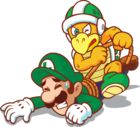
In Super Princess Peach, Bowser's minions, using the power of the Vibe Scepter, kidnapped Mario. They also kidnapped Luigi and Toad because they got in the way. Peach went on a quest to rescue them.
Bowser makes sure that he hid Luigi well because of what he had done in the past, which led him to hiding him late in the game.
Peach found Luigi trapped in a bubble in the boss level of Giddy Sky instead of a Toad. She defeated the boss, Giant Kamek and then freed Luigi.
Mario Strikers series
Super Mario Strikers
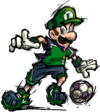
Luigi is a team captain in Super Mario Strikers (also known as Mario Smash Football in the PAL regions). He is a Playmaker player and his Super Ability is Super Luigi!. Luigi's number in Super Mario Strikers is 2, probably referring to his being Mario's "younger brother" and his being Player 2. His emblem is a lightning bolt, a possible nod to his Thunderhand in Mario & Luigi: Superstar Saga. In the game, his Super Strike is the Vicious Vortex.
Mario Strikers Charged
Luigi returns as a team captain in the sequel to Super Mario Strikers, Mario Strikers Charged (also known as Mario Strikers Charged Football in the PAL version). He is now classified as a Balanced player, and his Mega Strike uses electricity, most likely, again, referring to his ability from Mario & Luigi: Superstar Saga. Luigi's Super Ability is Super Luigi!, which allows him to become giant and crush his opponents, opening scoring opportunities, including Mega Strikes.
Mario Hoops 3-on-3
Luigi appeared in the game Mario Hoops 3-on-3, as a playable character. Luigi is a balanced-type character. To use his Special Shot the player had to tap the "L" to shoot the amazing Green Fire Shot. Luigi's baller name was the Mushroom Dynamite.
Itadaki Street DS
Luigi also appeared in Itadaki Street DS, where he joined many of his friends and Dragon Quest characters.
Mario & Sonic series
Luigi appears as a playable character within the Mario & Sonic series. Luigi's stats are balanced meaning he had no glaring weakness in any event. Luigi's emblem was his trademark green "L". Luigi also appeared in Mario & Sonic at the Olympic Winter Games. In the story mode in the DS version, he is found in Frostown Plaza where he challenges Mario and Sonic to a cross-country race. Luigi joins the party if they win. Luigi is later used in a minigame in Sparkleton, where he must grab a key from several Boos by collecting batteries for a lamp, then finding the key inside one of them. Later, the group meets King Boo, who is outraged that his Boos have been defeated, at Polastraits and he refuses to let them pass until Luigi beats him in Alpine Skiing GS. He later appears again in the third installment, Mario & Sonic at the London 2012 Olympic Games. Luigi also appears in Mario & Sonic at the Sochi 2014 Olympic Winter Games. Luigi appears again in Mario & Sonic at the Rio 2016 Olympic Games.
Mario Sports Mix
Luigi appeared in Mario Sports Mix, where he is classified as an all-rounder (all-around in North America) type character. His speed is average, while he has an above average technique. However, Luigi's power is below average. His special move involves Luigi pulling out his trusty Poltergust 3000 from Luigi's Mansion. Before shooting his special shot, Luigi would use the vacuum cleaner to suck in his opponents.
Fortune Street
Luigi returns as a playable character in the Wii follow-up to Itadaki Street DS, Fortune Street.
Other appearances
The first live-action portrayal of Luigi was in a commercial for Mario Bros. from 1983[6].
Luigi is the second best "property" in Nintendo Monopoly, losing only to his famous brother, Mario. Here, he replaces Park Place and costs $350.
In the board game Super Mario Chess, Luigi is the queen on Mario's team.
General information
Physical description
Luigi is very similar to his older brother in appearance, although Luigi is slimmer and taller. His face is noticeably thinner, and his hair is the same style as Mario's, but more of an auburn or dark maroon. Luigi's mustache is dark brown, sometimes black, and smooth, unlike Mario's mustache.
Luigi also wears clothes similar to Mario, but his shirt is green instead of red. Layered over the shirt is blue overalls, darker than Mario's. He also has brown work shoes, again darker than Mario's, with tan bottoms that reach above his ankles. Artwork however sometimes shows Luigi with the same color of blue overalls and brown shoes as Mario. In Luigi's Mansion, Luigi's shoes have Velcro on them, which is not present in any other game. Luigi's Cap is similar to Mario's Cap, being green instead of red and having an "L" replace Mario's signature "M"; the "L" was in italic from Mario Kart 64 to Luigi's Mansion for a few years. Artwork for the Mario & Luigi series has consistently depicted Luigi as wearing red and white striped socks; this trait is not present in any other games.
Mario and Luigi's color preferences are reflected throughout the land in the form of various enemies, such as Koopa Troopas and Cheep-Cheeps, who also come in red and green varieties. These foes even reflect the brothers' personalities, with red ones being more aggressive and green ones acting cautious. In fact, Mario and Luigi are not the only known red and green brothers, with similarly color-coded siblings including Cork and Cask, the Red and Green bridge guards, the Armored Harriers, Massif Bros., Elder & Junior Shrooboid and Gigi and Merri. When tattling the younger of the Armored Harriers, Goombella theorizes that it may be some sort of rule that younger brothers must wear green, offering a possible explanation for Luigi's trademark green shirt and hat.
However, Luigi has not always chosen to wear his usual green and blue clothes. Mario Bros. originally dressed Luigi in a black shirt and green overalls, although artwork showed his shirt to be red. Shigeru Miyamoto stated that the green color of clothing for Luigi was inspired by the enemy Shellcreeper[9]. Wrecking Crew gave him a magenta pair of overalls and helmet, seemingly leaving him shirtless. Even Super Mario Bros. gave its Luigi a green shirt and white overalls (although Super Mario Bros. Deluxe replaced this with a less aberrant brown shirt and green overalls, leaving his original colors to Fire Luigi, who usually has an inverse scheme), even though his usual palette and appearance had emerged in artwork.
Luigi has originated being a palette swap of Mario in his earlier adventures. This applies to Mario Bros., Wrecking Crew, Super Mario Bros., Super Mario Bros. 3, Super Mario World, Super Mario World 2: Yoshi's Island, and in a few versions of Mario is Missing!. Luigi's first depiction as taller and thinner is in Famicom Grand Prix II: 3D Hot Rally, although Luigi's first unique sprites came in Super Mario Bros. 2, in which his artwork appearance conveniently coincided with the tall Mama's sprite.[2] Nintendo of Japan would not adapt Luigi's artwork differences to his in-game sprite until Super Mario Kart, although Luigi's various models have been unique almost ever since, even in remakes of games where he was originally a palette swap (such as Super Mario All-Stars, Super Mario All-Stars + Super Mario World, Super Mario Advance 2, and Super Mario Advance 4).
Both Mario and Luigi have been described as "cutesy," to the extent that Shigeru Miyamoto considered redesigning them to "become a bit more grown-up" in the GameCube era, for instance by removing their trademark V sign.[10] However, aside from growing more realistic as graphics have advanced, Luigi and his brother have changed little over the years, and continue to flash the V sign regularly.
Luigi's appearance does, however, tend to lend itself to heavy stylization. The Luigi's Mansion graphical team took it upon themselves to animate every part of Luigi to convey emotion,[11] resulting in such exaggerations to the plumber's body as head-expanding screams during boss cutscenes and complete flattenings by fake doors. The Super Smash Bros. series applies Luigi's cowardice to his actions, making most of his attacks look reckless and unwilling and giving him awkward movements, securing his official title as the series' "dreamy, comical poster boy."[12]
Personality
Luigi is portrayed as timid and a bit of a coward. His cowardly attitude was first shown in Super Mario Adventures. He also worries and is considerably self-conscious. However, he overcomes his fears and acts like a hero when necessary. On the New Super Mario Bros. Wii website, it describes Luigi as "Mario's fearless brother". In keeping with his personality-based Power Flower, a sign in Big Boo's Haunt in Super Mario 64 DS describes Luigi as "wispy."
Arguably, Luigi's most apparent trait is his seeming cowardice. Though he showed several instances of cowardice in early non-game media such as The Super Mario Bros. Super Show!, his cowardly nature was not actually shown in-game until Luigi's Mansion (aside from a few hints in Paper Mario), and has carried over to almost all of Luigi's subsequent appearances. Although Luigi's phasmophobia is his most overbearing fear, he usually reconsiders at the mere thought of any monsters or trials, especially in the Mario & Luigi series. However, Luigi can be quite brave, and has saved the Mushroom Kingdom alongside his brother multiple times. Super Paper Mario especially glimpses into Luigi's more courageous side, showing him boldly rushing into dangerous situations and rarely even implicating his cowardice. In addition, the ending for Luigi's Mansion: Dark Moon also hinted that he got over his phasmophobia, or at the very least takes exception to Polterpups and made friends with the ghosts of Evershade Valley.
Another strong element of Luigi's personality is his apparent complex over being overlooked. Although his Superstar status has earned him many fans, including an entire fan club led by Toadia and multiple supporting Toads (one of which claims to be his biggest fan in Super Mario 64 DS), even Bowser and the Koopa Troop have occasional trouble with remembering his name (as seen in Mario & Luigi: Superstar Saga), and he appears to be almost unknown in the Beanbean Kingdom. Although Luigi's biggest reactions to his frequent overlookings in the Mario & Luigi series are a few "…"s and face-faults, his inattention was played up for comic relief in Paper Mario, with the snarky man in green complaining about being left behind and perpetually training for that elusive next adventure. Luigi's bio in Mario Party 5 states that he has been gaining popularity in recent years.
Luigi's state of being in the shadow of his brother shows strongly in Super Smash Bros. Brawl. An example would be the way Luigi is almost never happy, how his commentary is very monotoned, and how one of his taunts is a bashful kick of the ground. Also, his Final Smash, Negative Zone, seemed to have developed because of living in his brother's shadow forever. Additionally, whenever the crowd cheers for Luigi, not too many people are heard cheering for him and when the announcer says Luigi's name, he sounds a little surprised. Despite this, however, Masahiro Sakurai did not intend to play up Luigi's overshadowed status, instead aiming to make him "everyone's favorite man in green."[12]
When Luigi finally went on a quest of his own in Paper Mario: The Thousand-Year Door, he's presented as be more arrogant and somewhat of a liar, as he changes the stories of his adventure to make himself look better; his partners claim his stories are false. The novelizations of his escapades describe them with even more flowery exaggerations, stating for instance that he played an earth spirit in the Jazzafrazz Town Drama Slam (whereas he actually played grass on the side of the road, according to Hayzee) and that he awoke Cranberry with "a soft call" (rather than a sneeze).
In Mario & Luigi: Partners in Time, the Star Gate (which supposedly knows all) passes Luigi as "unworthy" to enter. This most likely has something to do with Luigi's "dark secret from his past," which it also mentions; Luigi did something either embarrassing or foolish which he has kept a secret ever since. However, in a interview with a member of staff, he stated Luigi had no dark secret, and it was actually a reference to Luigi's constantly living in the shadow of his brother. He also added: "Why make Luigi into a bad guy? We have Waluigi for that instead!" Even the game itself makes a straightforward point that Luigi has a large heart, as proven when he hits the Aurora Block and it grows to a gigantic size, flattening him.
In Mario Strikers Charged and Mario Kart Wii, Luigi is shown to cry when he is frustrated and losing a game.
Luigi is also portrayed as somewhat refined, leading the "Luigi Gentlemen" in Mario Superstar Baseball. Luigi's Mansion shows him to be a bit of a neat freak, constantly criticizing the dustiness of his mansion and even mentioning at one point that he hand washes his cap as opposed to using a washing machine as his brother does. He also seems to have an eye for art, but doesn't appreciate many of King Boo's decorations. Luigi has been known to cross-dress several times. The first time was in Super Mario Adventures, second in Mario and Luigi: Superstar Saga and third was (implied) in Paper Mario: The Thousand Year Door. Like Toadette, Luigi can be sensitive when someone insults him, especially if the jab in question regards his mustache (as proven prior to his showdown with Dimentio). Luigi also appears to show concern for cruelty to animals; he is horrified by the deer heads and leopard skin rugs in the Safari Room in Luigi's Mansion and declares that he won't stand for an animal being treated in such a manner.
Whereas Mario rarely speaks in the video games aside from numerous yells and grunts (a point is made out of this in Super Mario RPG: Legend of the Seven Stars with Toad and The Thousand-Year Door with Doopliss), Luigi is proven to be quite the conversationalist in the Paper Mario series, except in Paper Mario: Sticker Star. When speaking, he talks in a strong Italian accent like his brother. In Super Paper Mario, Luigi is almost Mario's "mouth". He does all the speaking for Mario in the beginning of the game (a role later taken by Tippi). Once he joins Mario's party, however, he talks only during scenes where the four heroes are shown together. Curiously, the inverse seems to be the case in the rare instance of a Luigi-only quest; both brothers are capable of captioned speech in Luigi's Mansion, but Luigi is limited to ellipses and question marks when interacting with another character. In the Mario & Luigi series, Luigi, as well as Mario, talks in gibberish that the player can't interpret, but the other characters in the game do.
Super Mario Adventures downplays his cowardice altogether, instead portraying him as rash and willing to make choices without putting much thought into them. His main characteristic here is greed. However, his greed is not for money as it was in the anime, but for food; when the brothers came across a haunted house, Luigi was drawn in immediately by the smell of cheese.
In The Super Mario Bros. Super Show! Luigi is consistently portrayed as being the smarter of the two, but the cowardice trait is also shown as Luigi is scared of things going very wrong. He also doesn't take as many risks as Mario does.
Revealed in Mario & Luigi: Dream Team is that he is willing to help his brother whenever he is in danger. He thinks that Mario is much cooler than he is, that he adores his brother because of this trait. The messages that appear in Dream's Deep further explains this trait.
Overall, Luigi's personality is hard to determine and tends to change depending on the appearance. Very few games have portrayed him with a personality that lasts throughout the subsequent release. Overall, however, Luigi can be described as timid and cautious, yet kindhearted and willing to protect his homeland with Mario's help, and a bit negative.
Age
Luigi was initially introduced as Mario's much younger brother. The first indication of their specific age difference was in Family Album "The Early Years", which implied that Luigi was born after Mario by several years.
However, Super Mario World 2: Yoshi's Island and Yoshi Touch & Go[13] described the brothers as twins. The remake of the former, Yoshi's Island: Super Mario Advance 3, did not expressly call them twins, but noted that Luigi was Mario's younger brother, carried to their parents at the same time.
Many video game sources still refer to Luigi as the younger brother, indicating that Luigi may have been the second born twin. In Super Paper Mario, Luvbi refers to Mario and Luigi as twins at the end of chapter 7-1. Despite the small age difference, Luigi directly refers to Mario as "big bro" in the same game on more than one occasion. Also, while Luigi's Trophy description in Super Smash Bros. Brawl also referred to him as "younger twin brother", Colonel Roy Campbell calls Luigi a "kid brother" to Snake during Snake's Codec conversation in the same game. In the Mario cartoon series, Luigi playfully refers to Mario as his "little big brother". Since Mario is stated to be 26 years old in the Japanese version of Super Smash Bros. Melee, provided it is correct, Luigi is also 26 years old.
Powers and abilities
As to not give players advantages over each other, Luigi's abilities are usually exactly the same as Mario's, such as in Mario Bros., Super Mario Bros., and Super Mario World. In most instances where one player can choose between the two brothers, however, Luigi is given his own gameplay quirks. This first occurred in Super Mario Bros.: The Lost Levels, where Luigi can jump higher than Mario but has lower traction and speed. In the American Super Mario Bros. 2, Luigi once again features the highest jump, but comparatively low speed and power. Luigi's high jumps but low traction would return in Super Mario Advance 2: Super Mario World, which, unlike its original version, allowed players to switch between Mario and Luigi at any time on the map screen. In three-dimensional adventures, such as Super Mario 64 DS, Super Mario Galaxy, and Super Mario Galaxy 2 Luigi is usually faster than Mario (at the cost of poorer acceleration), but retains his classic high jumps and poor traction.
As aforementioned, Luigi has a higher top speed but poorer acceleration than his brother in Super Mario 64 DS, along with poor traction and increased agility. In this game Luigi along with Yoshi are the fastest swimmers. Luigi's jumps are perhaps at their strongest in this game; not only can Luigi jump higher than his brother, but he can also scuttle to slow his fall. His backflip has the same effect as being caught in a Tweester or stomping a Fire Guy, allowing for a very slow descent. Unlike Mario, however, Luigi cannot Wall Jump in this game. As a result of his agility and lightness, Luigi can walk on water for a short time. Luigi's Power Flower is Vanish Luigi, allowing him to disappear for invincibility and the ability to walk through certain obstacles.
In Super Paper Mario, Luigi's specialty is the Spring Jump, which sends him just off the screen to bound over obstacles and damage enemies mid-air. His standard jumps are also higher than any other character's and he has lower traction once more. However, the player can simply press down to stop instantly in this game (due to his Spring Jump).
Electricity is sometimes depicted as Luigi's answer to Mario's fire. In Mario & Luigi: Superstar Saga, Luigi is given the ability to harness and release electricity with a technique known as the Thunderhand (alongside his other specialty, the High Jump). This is referenced in Super Paper Mario with Mr. L's nickname of "The Green Thunder," and in Mario Strikers Charged, where Luigi's Mega Strike involves controlling electricity.
In addition to actual gameplay differences, Luigi often executes his moves differently than his brother. In Super Mario All-Stars + Super Mario World, Luigi jumps with his legs back and descends with them forward, kneels when sliding, and appears to spit fireballs rather than throwing them. The Super Smash Bros. series and Mario Kart: Double Dash!! give Luigi green fireballs, and in the former games his fireballs levitate. Perhaps most famously, Luigi's jumping animation in Super Mario Bros. 2 is merely his walking animation sped up; although Luigi's "kicking" jumps were momentarily ignored, they returned in the Super Mario Advance series, complete with a high-pitched warbling sound effect in Super Mario Advance 2 and 4. Luigi's aforementioned scuttle from Super Mario 64 DS also involves walking in mid-air, and the Eternal Understudy "kicks" during his Triple Jump in Super Mario Galaxy and Super Mario Galaxy 2.
Luigi has also exhibited many unique traits in various sports and spin-off games, despite usually being a balance character like his brother. In games such as Mario Kart Wii, Luigi has a higher top speed than Mario, but has lower handling and acceleration. In the Mario Golf series, Luigi hits with less power than his brother but features better control, although his shots consistently curve left. Luigi is slightly faster than Mario in Mario Superstar Baseball, and reveals his special pitch and swing (the Tornado Ball and Tornado Swing, respectively) in Mario Super Sluggers.
Despite his skills, Luigi is also somewhat clumsy. For example, in Paper Mario: The Thousand-Year Door, he accidentally bumps one of his partners, Blooey the Blooper, into a volcano while trying to stop evil, burning him to a golden crisp but not killing him. Usually, though, he is very agile and can do many stunts Mario can not, and in fact appears to be the best jumper in the Mushroom Kingdom and he is shown to be a good breakdancer in Mario & Sonic at the Olympic Games whenever he gets a gold medal he breakdances like Sonic, and in the events Sychronized Swimming, Figure Skating, and Rhythmic Ribbon, he is shown to be flexible and a good gymnast because of his long legs.
Roles taken
Luigi is a hero, but usually a sidekick, although in some media and games he is referred to as a partner. In the Mario & Luigi games, he is the cowardly partner to Mario, and is occasionally forced to be brave. He is the hero of a separate adventure the player doesn't get to play or see in Paper Mario: The Thousand-Year Door, where he is a coward who changes the story to make himself look more heroic. In Super Paper Mario he was not a sidekick, but rather one of the four heroes, which made him equal to Mario. He was also brainwashed by Nastasia to become a villain, Mr. L, and was later brainwashed again by Dimentio to become Super Dimentio, the final boss. His sidekick role was completely different in Mario is Missing!, Luigi's Mansion and its sequel, where he was the sole main character who had to rescue Mario.
Relationships
Family
Luigi often accompanies his older twin brother Mario on his adventures, most prominently in the Mario & Luigi series. While there is some sibling rivalry between the two[14], with Luigi sometimes feeling jealous and overshadowed by his brother, he also admires and looks up to him, wishing to be "a great plumber like his brother Mario" in Super Mario RPG. The two share a loving twin bond so strong that as babies, Baby Mario could sense where his brother was after they were separated by the Koopas. This closeness continues into adulthood, with the brothers frequently coming to each other's aid and rescue. While Mario is generally the more heroic and active of the two, Luigi has saved him on a few occasions, starting with Mario is Missing! and subsequently in Luigi's Mansion, and its sequel, Dark Moon, wherein Mario calls Luigi "number one" upon his rescue.
Friends
One of Luigi's closest friends is Yoshi, and the two are often referred to as "The Green Team" when partnered up in spin-offs, although in he Mario Baseball series their chemistry is only neutral. Their relationship is much closer in the Super Mario World TV Show, which depicted Yoshi as having originally thought Luigi was his mother and still enjoys hearing him tell him bedtime stories, as seen in the episode Mama Luigi. He is also good friends with Toad, although they are not quite as close as Toad is with Mario, and while other Toads are almost unanimous in their praise and adoration of Mario, their opinions on Luigi vary greatly between individuals. Some are unabashed fans of Luigi, with one in Super Mario 64 even asserting that "We'll have to call you the Luigi Brothers soon!", while others are disbelieving that Luigi should measure up to Mario, with one going so far as to call him "The world's most inept and least charismatic brother". Similarly, Luigi's relationship with Starlow is far less cordial than she is with Mario, with her often belittling and mistreating him, but at the same time acknowledging that despite not being as great as Mario, he is still a hero.
Princess Peach is another one of Luigi's good friends, with him often accompanying Mario on quests to rescue her from Bowser, the two sharing good chemistry in the Baseball games, and overall friendly behaviour seen between them, occasionally overlapping with hints of romantic attraction as well. Luigi is seen swooning over Peach after she blows a kiss in her Mario Power Tennis victory scene, and in games where Luigi can be substituted for his brother, her interactions with him are the same as they would be with Mario, such as rewarding him with a kiss at the end of most Super Mario platformers, or even being referred to as "special one" by Rosalina in Super Mario Galaxy. Overall, however, the two are portrayed as simple friends, with Daisy serving as Luigi's main love interest, although he has also expressed interest in the unseen Princess Eclair of the Waffle Kingdom. He has also been speculated to have an interest in Rosalina owing to the fact that he and Rosalina are photographed together just as Peach and Mario were pictured together in the image sent by the Mailtoad in Grand Finale Galaxy, and to the fact that he only gives Mario the Green Stars he collected in Battlerock Galaxy if Mario tells Rosalina they're from Luigi.
It has been stated that Luigi has a crush on Daisy, and the attraction appears to be mutual. In Daisy's second appearance in the Mario series, NES Open Tournament Golf, she served as Luigi's caddy, just as Peach was caddying for Mario, and as her trophy in Super Smash Bros. Melee points out, since that point "some gossips started portraying her as Luigi's answer to Mario's Peach". They are often paired up in spin-off games: they are seen golfing together in Mario Golf Toadstool Tour, are "buddy players" with good chemistry in the Mario Baseball series, they appear together in the Miracle Book pages from Mario Party 6, and in Mario Kart Wii, there is a giant, golden statue on the Daisy Circuit that shows the two holding hands and dancing together, along with another of Baby Luigi and Baby Daisy. Their team names from the Mario Party series include, "Steady Sweeties" and "Tango Tanglers", and when Daisy received her trophy from Luigi in Mario Power Tennis, she says, "Hey, sweetie! I'll take that".
Another one of Luigi's friendships can also be seen with Professor E. Gadd. Although the only interactions between the 2 were in the Luigi's Mansion series, they worked very well together. E. Gadd shows much trust in Luigi, despite Luigi's cowardly nature. Throughout Luigi's Mansion: Dark Moon, E. Gadd jokingly held Luigi in low regards, though he also states to be proud of him for courageously exploring the hostile ghost filled mansions as well as defeating the various possessor ghosts.
Enemies
Bowser's main rivalry is with Mario, and while he views Luigi as almost a great a threat as his brother in games such as Super Mario Galaxy and its sequel, at other times, Bowser has trouble even remembering Luigi's name, particularly in the Mario & Luigi series where he often defaults to calling him "Green 'Stache" (Although Bowser finally calls Luigi by his real name at the end of Mario & Luigi: Dream Team). Rather than Bowser, Luigi's arch-nemesis is actually King Boo, who he met and defeated single-handedly in Luigi's Mansion when the ghost kidnapped Mario. King Boo would later try to get revenge in Luigi's Mansion: Dark Moon, and the rivalry can be seen in other series as well, such as the Mario Baseball games, in which they share bad chemistry, or Super Mario 64 DS, where King Boo (Known as Big Boo in the English version) was the one to lock Luigi away.
Another heated rivalry exists between Luigi and Waluigi, with the two sharing bad chemistry in all the games they appear in together, and acting hostile and rude towards each other, such as Luigi making a gesture at Waluigi to anger him in Mario Tennis, the two scowling at each other in the Mario Party 3 group picture, and Waluigi´s vandalism of Luigi´s picture in the opening movie of Mario Power Tennis. Waluigi is constantly seen harassing Luigi, whether by humiliating him during the sports competition, following him wherever he goes or even directly confronting him. The origins of their animosity are unknown, however jealousy may be a factor, as both Luigi and Waluigi have crushes on Princess Daisy. Luigi himself, while he despises Waluigi, prefers to ignore him and his antics.
Just as Luigi's relationships with Daisy and King Boo mirror Mario's relationships with Peach and Bowser, respectively, so too does Luigi's rivalry parallel the one between Mario and Wario. Wario himself does not show as much antagonist towards Luigi as Waluigi, although the two do not get along well and it has been shown that Wario enjoys giving Luigi trouble, such as by tying his shoelaces together[15].
Nicknames
Since Mario has starred in many more games and has been on many more adventures than Luigi, he has received most of the popularity; almost everyone knew who Mario was. Luigi, on the other hand, has smaller popularity compared to Mario's and is unknown to most. Luigi's nicknames usually have to do with the color of his clothing.
- The Luigi Kid - The Super Mario Bros. Super Show!
- Long John Spaghetti (by Mario) - The Super Mario Bros. Super Show!
- Mama Luigi (by Yoshi, and later himself) - Super Mario World television series
- Weegee (by Mario) - Super Mario Adventures
- Plunger Puss (by Larry Koopa) - Mario is Missing!
- Plumber Dude (by Larry Koopa) - Mario is Missing!
- The Eternal Understudy - Super Smash Bros.
- Master Luigi (by Toadsworth) - Mario & Luigi: Superstar Saga
- Mr. Green (by Bowser) - Mario & Luigi: Superstar Saga
- Green Guy - Mario & Luigi: Superstar Saga, Super Princess Peach, Mario & Luigi: Paper Jam
- Mr. Green Mario Brother Guy (by Bowser) - Mario & Luigi: Superstar Saga
- Green man of mustache (by the star gate) - Mario & Luigi: Partners in Time
- Green 'stache (by Bowser) - Mario & Luigi: Superstar Saga, Mario & Luigi: Partners in Time, Mario & Luigi: Bowser's Inside Story, and Mario & Luigi: Dream Team (also called by a Whittle in Super Mario Galaxy 2)
- Mr. Lean 'n' Green - Mario & Luigi: Superstar Saga
- Mr. Greenie - Mario & Luigi: Superstar Saga
- What's-yer-name (by Bowser) - Mario & Luigi: Superstar Saga
- The Other Guy - Mario & Luigi: Superstar Saga
- Lip Hair (by Baby Bowser) - Mario & Luigi: Partners in Time
- Shabby green mustachioed man (by Princess Lipid) - Mario & Luigi: Bowser's Inside Story
- Man in Green (by Dark Prognosticus) - Super Paper Mario (also known as the "man in green" in Super Smash Bros. Melee in the notice after unlocking Luigi)
- Mr. Lime-Green - Luigi's Mansion
- The Mustachioed Green Baron - Paper Mario: The Thousand-Year Door
- Mr. Eyeballs (by Waluigi) - Mario Power Tennis
- Mushroom Dynamite - Mario Hoops 3-on-3 baller name
- Sweetie (by Daisy) - Mario Power Tennis
- King of Second Bananas (by Colonel) - Super Smash Bros. Brawl
- Green Wimp (by Bowser) - Mario & Luigi: Partners in Time
- The Green Thunder (as Mr. L) - Super Paper Mario
- The Great Dweeb (by a Goomba) - Super Paper Mario
- Green Wonder - Super Smash Bros. Brawl
- Everyone's favorite man in green (by Masahiro Sakurai) - Super Smash Bros. Brawl website (Smash Bros. DOJO!!)
- Air Luigi (by Koopa Koot) - Paper Mario
- Mysterious Green Guy - Paper Mario: Sticker Star
Profiles and statistics
- Main article: List of Luigi profiles and statistics
Mario Tennis series
Mario Tennis
- Type: All-Around
- Instruction Booklet Bio: His height lets him hit even the balls that look like they're out of reach.
Mario Power Tennis
- Type: All-Around
- Offensive Power Shot: Squeaky Mallet
- Defensive Power Shot: Poltergust Return
- Stats:
- Power: 6/10
- Speed: 7/10
- Reach: 7/10
- Serve: 6/10
- Lunge: 7/10
- Control: 7/10
- Doubles Partner: Mario
- Bio: Luigi has better ball control than his famous sibling and is especially skilled at volleying.
Mario Tennis Open
- Type: All-Around
- Bio: Compared to Mario, he is a bit less powerful, but Luigi is good at ball handling. His specialty is playing up front, at the net.
- Bio 2: Like his brother, Luigi is pretty good at everything. Although not as powerful as Mario, he has greater accuracy and is excellent at coming into the net.
Portrayals
A list of all the people who have portrayed Luigi.
- Yuu Mizushima - Super Mario Bros.: Peach-hime Kyushutsu Dai Sakusen!
- Charles Martinet - 1996 - Present
- Marc Graue - Hotel Mario
- Danny Wells - The Super Mario Bros. Super Show!
- Tony Rosato - The Adventures of Super Mario Bros. 3, Super Mario World
- Julien Bardakoff - Mario Kart 64; (Japanese version only), Mario Party, Mario Party 2, Mario Kart Super Circuit
Gallery
- Luigi Mario Bros.png
- MKLG.PNG
- TanookiLuigi.png
Quotes
- Main article: List of quotes by Luigi
- "Oh, yeah!" - Various games
- "Okey dokey!" - Various games
- "Let's-a go!" - Various games
- "Yay for me!" - Mario Party 9
- "I'm-a Luigi, Number One!" - Mario Kart 64
- "Hello...?" - Luigi's Mansion/Luigi's Mansion: Dark Moon
- "Come here, doggy." - Luigi's Mansion: Dark Moon
- "MARIO!!!" - Luigi's Mansion/Luigi's Mansion: Dark Moon
- "You wanna switch, bro?" - Super Mario Galaxy/Super Mario Galaxy 2
- "Oh yeah, who's number one now? Luigi!" - Mario Kart: Double Dash!!
- "Oh, this look bad." - Mario Power Tennis
- "Thanks, bro!" - Super Mario 3D Land
- "Hey! You know what would look good? A spaceship with MY face on it!" - Fortune Street
- "Yes! Luigi won!" - Mario Party 8
- "Whew! Made it!" - New Super Mario Bros. Wii
- "Oh, what happened?" - Mario Kart 8
- "Ha ha ha! I'm the best!" - Mario Party 4/Mario Party 5
Games
Mario comics
- Main article: List of quotes in Mario Comics § Luigi
Mario cartoons
- The Super Mario Bros. Super Show!
- Main article: List of quotes in The Super Mario Bros. Super Show! § Luigi
- The Adventures of Super Mario Bros. 3
- Main article: List of quotes in The Adventures of Super Mario Bros. 3 § Luigi
- Super Mario World
- Main article: List of quotes in the Super Mario World television series § Luigi
See also
Names in other languages
Trivia
- Coincidentally, "Luigi" translates to Italian as "famous warrior", which is ironic or apt given the circumstance. Luigi is often portrayed as being the "lesser brother", although he is an iconic video game hero as well.
- When Luigi is pretending to threaten the Waddle Dees in his first cutscene in Super Smash Bros. Brawl, a Western-like cover version of the Luigi's Mansion theme plays.
- In the first page of the Nintendo Power magazine for Luigi's Mansion, Luigi is accidentally called Mario's "older brother." This is probably a typo, as Luigi is known as the younger brother.
References
- ^ The Mushroom Kingdom (Accessed on 7-2-09)
- ^ a b c McLaughlin, Rus (November 8, 2007). IGN Presents The History of Super Mario Bros. IGN. (Accessed on 6-28-09)
- ^ The International Arcade Museum (Accessed on 7-2-08)
- ^ Mario Bros. - Videogame by Nintendo. The International Arcade Museum at Museum of the Game. Retrieved July 27, 2015.
- ^ News article covering interview with Shigeru Miyamoto. Retrieved January 24, 2015.
- ^ a b Commercial for Atari Mario Bros. featuring a live-action Luigi.
- ^ Print ad for Mario Bros.
- ^ https://miiverse.nintendo.net/posts/AYMHAAACAADMUKlpzooN0A
- ^ [1]
- ^ IGN (Accessed on 7-6-09)
- ^ N-Sider (Accessed on 6-28-09)
- ^ a b Smash Bros. DOJO!! (Accessed on 6-28-09)
- ^ The Yoshi Touch & Go instruction booklet states that the Stork is carrying a pair of newborn twins (referring to Mario and Luigi) on page six.
- ^ The Super Mario Kart manual (page 21) states that "Mario and Luigi have had a friendly rivalry that goes back to their childhood."
- ^ Wario Land 4 official website (now defunct) (Accessed on 7-3-09)
- Heroes
- Plumbers
- Humans
- Siblings
- Koopa Troop
- Hostages
- Magicians
- Police
- Shopkeepers
- Merchants and Salespeople
- Captains
- Pirates
- Characters
- Playable Characters
- Unlockables
- Allies
- Bosses
- Cloned
- Forms
- Mario Doppelgängers
- Dance Dance Revolution: Mario Mix
- Fortune Street Characters
- Hotel Mario
- Itadaki Street DS Characters
- Mario & Luigi: Bowser's Inside Story
- Mario & Luigi: Dream Team Characters
- Mario & Luigi: Superstar Saga
- Mario & Wario
- Mario & Sonic at the London 2012 Olympic Games
- Mario Golf 64
- Mario Golf GBC
- Mario Golf: Toadstool Tour
- Mario Golf: Advance Tour
- Mario Golf Characters
- Mario Golf: World Tour
- Mario Hoops 3-on-3 Playable Characters
- Mario is Missing!
- Mario Kart 64
- Mario Kart 7
- Mario Kart 8
- Mario Kart: Double Dash!! Characters
- Mario Kart DS Characters
- Mario Kart Series Playable Characters
- Mario Kart: Super Circuit
- Mario Kart Wii Characters
- Mario Kart Wii Trading Cards
- Mario Party
- Mario Party 2
- Mario Party 3
- Mario Party 4
- Mario Party 5
- Mario Party 6
- Mario Party 7
- Mario Party 8
- Mario Party 9
- Mario Party 10
- Mario Party Advance
- Mario Party Characters
- Mario Party DS
- Mario Party: Island Tour
- Mario Power Tennis Characters
- Mario Sports Mix
- Mario Strikers Charged Characters
- Mario Super Sluggers Playable Characters
- Mario Superstar Baseball Characters
- Mario Tennis 64
- Mario Tennis GBC
- Mario Tennis Open
- Mario Tennis: Power Tour Characters
- Mario's Tennis
- NES Open Tournament Golf
- Super Mario Advance 4: Super Mario Bros. 3
- New Super Mario Bros. 2 Characters
- New Super Mario Bros. U
- New Super Mario Bros. Wii Trading Cards
- Paper Mario Characters
- Paper Mario: The Thousand-Year Door Characters
- Paper Mario: Sticker Star Characters
- Paper Mario Series Party Members
- Puzzle & Dragons: Super Mario Bros. Edition
- Super Mario Bros.
- Super Mario Bros. 2
- Super Mario 3D World
- Super Mario amiibo Line
- Super Mario Bros. Deluxe
- Super Mario Galaxy Trading Cards
- Super Mario Strikers Characters
- Super Paper Mario Bosses
- Super Paper Mario Characters
- Super Princess Peach
- Super Smash Bros. amiibo Line
- Super Smash Bros. Brawl Fighters
- Super Smash Bros. Brawl
- Super Smash Bros. for Nintendo 3DS / Wii U Fighters
- Super Smash Bros. for Nintendo 3DS / Wii U
- Super Smash Bros. Fighters
- Super Smash Bros. Melee Fighters
- Super Smash Bros. Melee
- Super Smash Bros. Stickers
- Super Smash Bros. Trophies
- Yakuman DS
- Twins
